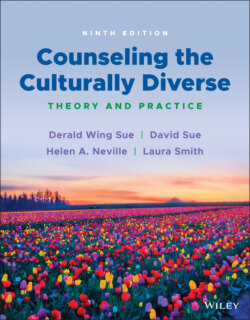Читать книгу Counseling the Culturally Diverse - Laura Smith L. - Страница 77
STYLES OF COMMUNICATION
ОглавлениеCommunication style refers broadly to those factors that go beyond the content of what is said. Communication specialists have historically found that only 30–40% of what is communicated conversationally is verbal (Ramsey & Birk, 1983; Singelis, 1994), meaning that a large portion of what is communicated in an interaction derives from nonverbal and other sources. In other words, what people say and do is usually qualified by other things that they say and do. A gesture, tone, inflection, posture, or degree of eye contact may enhance or negate the content of a message. Communication styles have a tremendous impact on our face‐to‐face encounters with others (Geva & Wiener, 2015). Whether our conversation proceeds in fits and starts, whether we interrupt one another continually or proceed smoothly, the topics we prefer to discuss or avoid, the depth of our involvement, and the forms of interaction (e.g., ritual, repartee, argumentative, persuasive) are all aspects of communication style. Some refer to these factors as the social rhythms that underlie all our speech and actions. Communication styles are strongly correlated with race, culture, and ethnicity (Garrett & Portman, 2011; Ivey, Ivey, & Zalaquett, 2014); gender has been found to be a powerful determinant of communication style as well (Pearson, 1985; Robinson & Howard‐Hamilton, 2000). Communication style can be analyzed via a number of specific dimensions, including paralanguage, proxemics, kinesics, and other forms of nonverbal expression.
